This page is http://www.mmdtkw.org/RT04-ALRI-2004RomeTrip.htmlALRI Roman History
(Click on the logo above to go to the ALRI web site and on the words above to go to ALRI Roman History Pages)
This page is http://www.mmdtkw.org/RT04-ALRI-2004RomeTrip.htmlALRI Roman History
(Click on the logo above to go to the ALRI web site and on the words above to go to ALRI Roman History Pages)

Trip to Rome -- September 2004
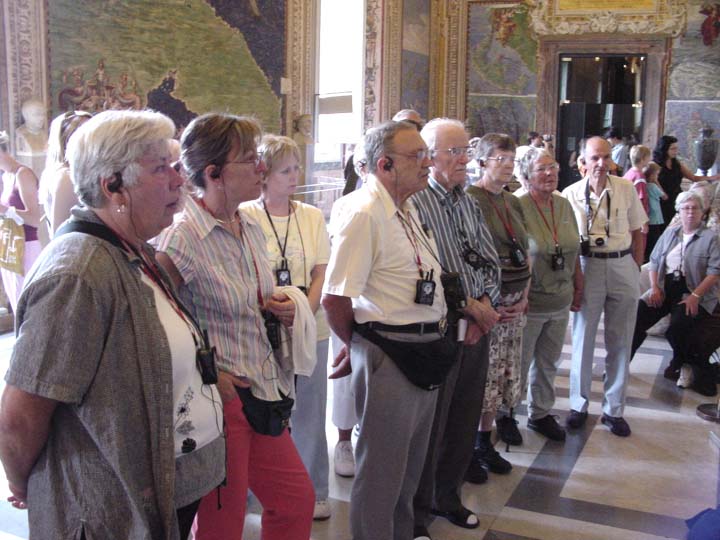
Some members of the group in the Map Corridor of the Vatican Museums
Listed below are links to papers prepared for the trip:Area Sacra -- Four Early Republic Temples at Piazza Argentina
http://www.mmdtkw.org/RT04-AreaSacraArgentina.htmlThe Crypta Balbi Museum -- urban archeology
http://www.mmdtkw.org/RT04-CryptaBalbiMuseum.htmlBaths of Caracalla
http://www.mmdtkw.org/RT04-CaracallaBaths.htmlBaths of Diocletian
http://www.mmdtkw.org/RT04-BathsDiocletian.htmlCampus Martius plan/map
http://www.mmdtkw.org/RT04-CampusMartiusPlan.htmlCapitoline Hill plan/map
http://www.mmdtkw.org/RT04-CapitolinePlan.htmlAmphitheater -- the Flavian Amphitheater/Colosseum and the Ludus Magnus Gladiator School
http://www.mmdtkw.org/RT04-ColosseumRotation.html
http://www.mmdtkw.org/RT04-LudusMagnus.htmlForum Boarium (animal/meat market) and Forum Holitorium (fruit/veg market) in the ancient port area
http://www.mmdtkw.org/RT04-ForumBoarium.html
http://www.mmdtkw.org/RT04-ForumHolitarium.htmlForum Romanum -- the Republican Forum
http://www.mmdtkw.org/RT04-ForumRomanum.htmlImperial Forums -- plan/map and pictures of models
http://www.mmdtkw.org/RT04-ImperialForums.htmlTomb of Hadrian = Castel Sant'Angelo
http://www.mmdtkw.org/RT04-HadrianTomb.htmlPalatine Hill and Caesars' Palaces
http://www.mmdtkw.org/RT04-PalatineHill.htmlThe Pantheon
http://www.mmdtkw.org/RT04-Pantheon.htmlTiber Island = Isola Tiberina -- quarantine and medical center since ancient times
http://www.mmdtkw.org/RT04-TiberIsland.htmlTrajan's Column and Market
http://www.mmdtkw.org/RT04-TrajanColumn.html
http://www.mmdtkw.org/RT04-MarketsTrajan.html
All papers are for study use only.
Information, some text, and most images in the papers are drawn from other Internet sites under the "fair-use" rubric. None of this material should be used for any commercial purposes.
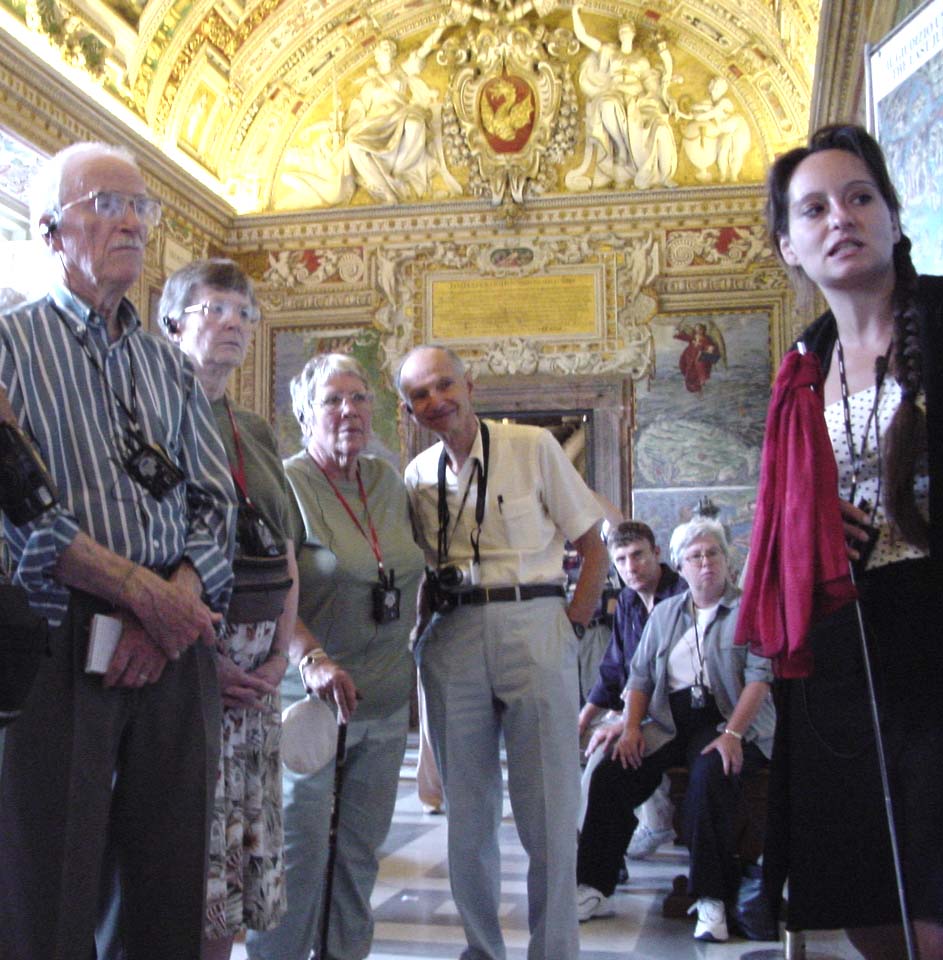
In the Vatican Museums
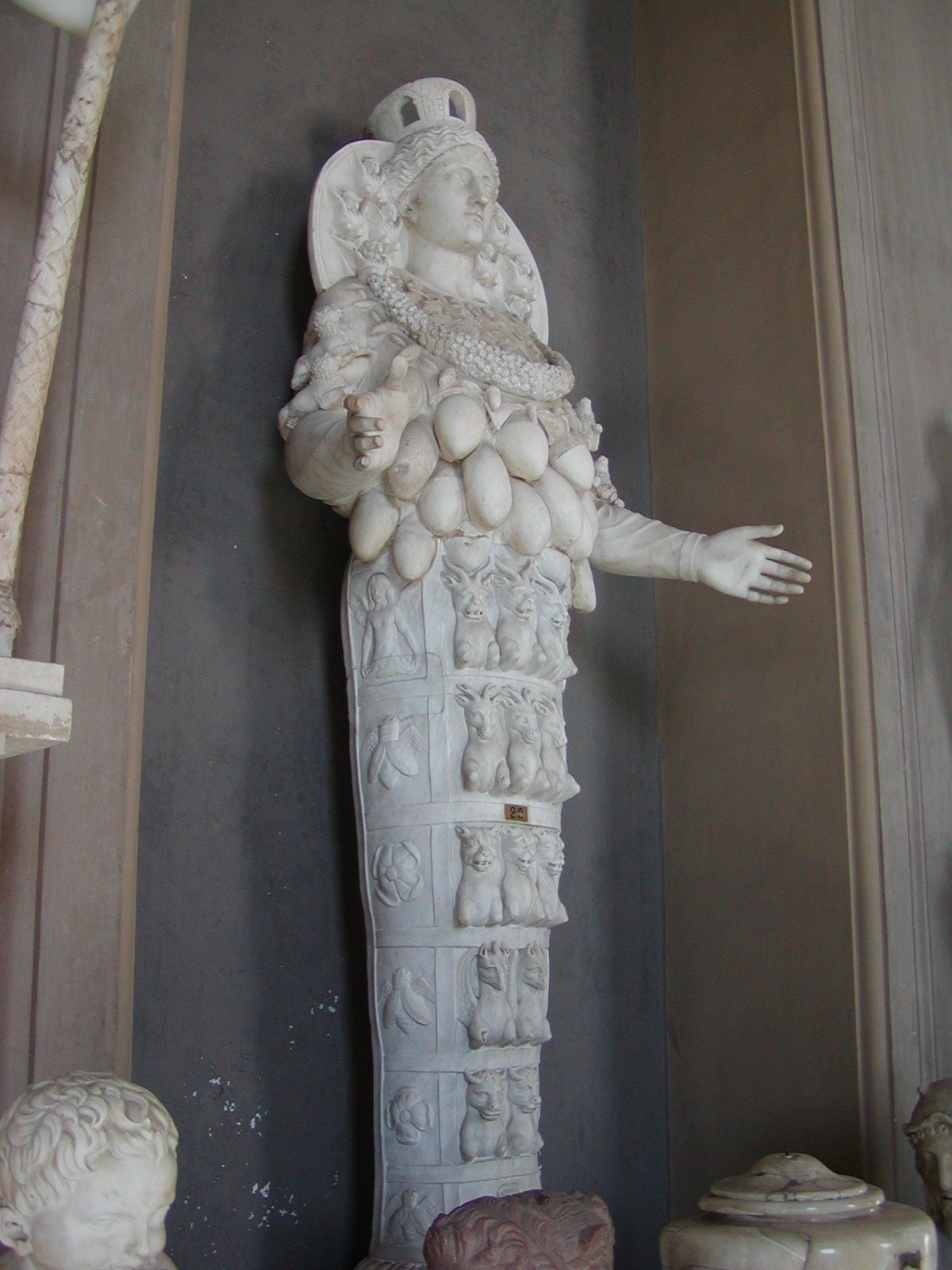
Diana (Artemis) of Ephesus statue in the Candelabra Gallery, Vatican Museums. Very heavily restored in Renaissance times -- arms, some breasts, the body below the breasts, head-dress, and perhaps the head and nimbus are not original. (This, of course, leaves very little that is original -- but many other images were available to the restorer for comparison.) Based on the decoration on the sides of the lower torso and long skirt, some experts speculate that this may be a Gianlorenzo Bernini restoration for Pope Urban VIII (Mafeo Barberini): the bees on the side of the skirt look like Barberini bees and the rosettes appear to be the symbol of the Riario Family.
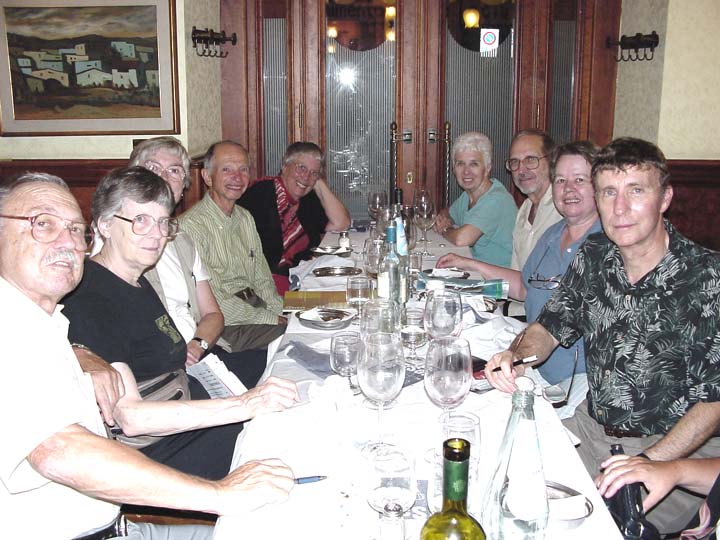
Dining out on the first night of the trip
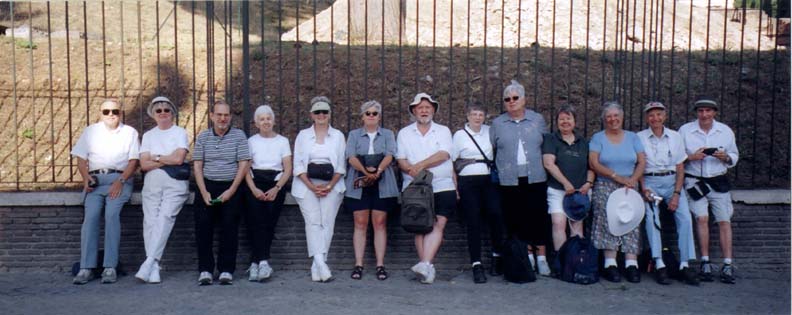
Resting near the Arch of Constantine
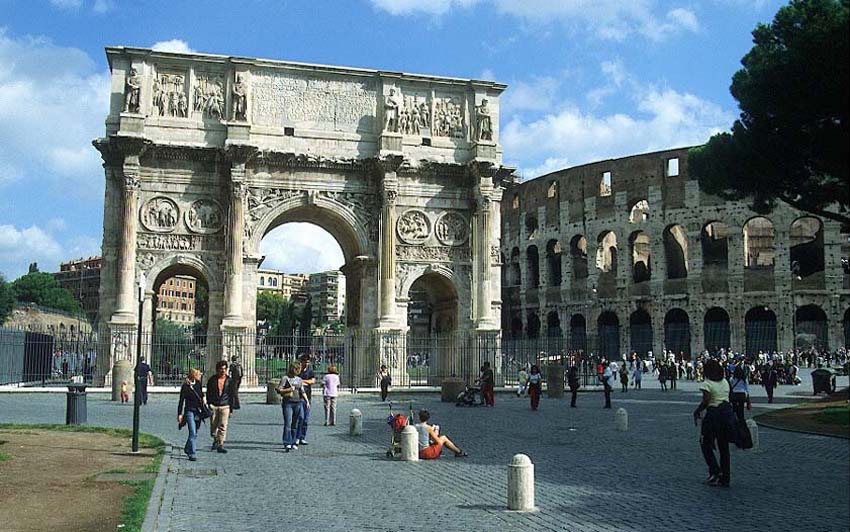
Constantine's Arch, adjacent to the Colosseum, was dedicated in 322 AD, the tenth anniversary of Constantine's triumph over his rival Emperor, Maxentius. It replaced a temporary wooden triumphal arch that had been erected over this section of the Via Triumphalis at the time of Constantine's entry into Rome in 312. Almost all of the decorative elements are "spolia", that is, they were stolen from monuments to earlier emperors: only the narrow band of carvings below the roundels date from the time of Constantine, and they are clearly degenerate.
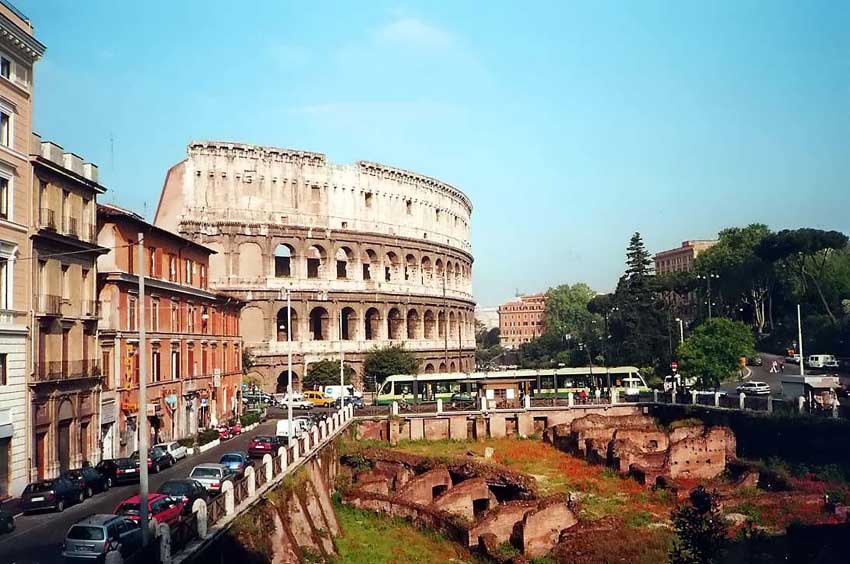
Excavated portion of the Ludus Magnus gladiator school (foreground) and the Colosseum
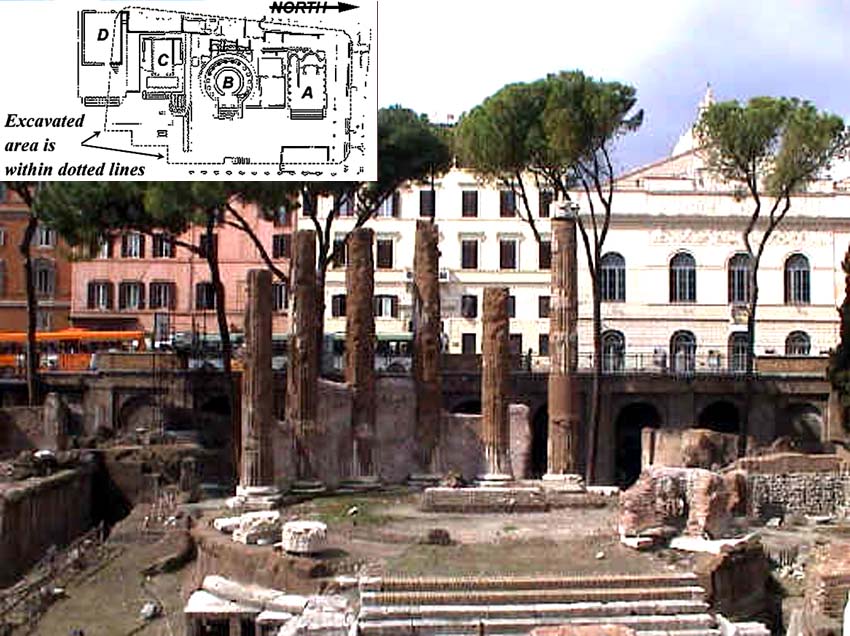
The Area Sacra at Largo Argentina. Outside the back end of the rectangular porticoed courtyard behind the Theater of Pompey, four unidentified temples from the early Republican period of Ancient Rome have been excavated: this photo shows what remains of Temple B, several pillars of which have been re-erected. Inside the back end of the Pompey Theater courtyard (under the modern buildings in the background) was a meeting hall or Curia where the Roman Senate was meeting temporarily in 44 BC, their normal meeting hall in the Forum having been destroyed by fire in a riot in 52 BC. It was on the staircase of the temporary Curia that Julius Caesar was assassinated. The white building in the background at the right side of the picture is the Teatro Argentina, a 19th century building where Verdi's operas had their Roman premiers, and for that reason the site of Caesar's assassination has not been exposed.
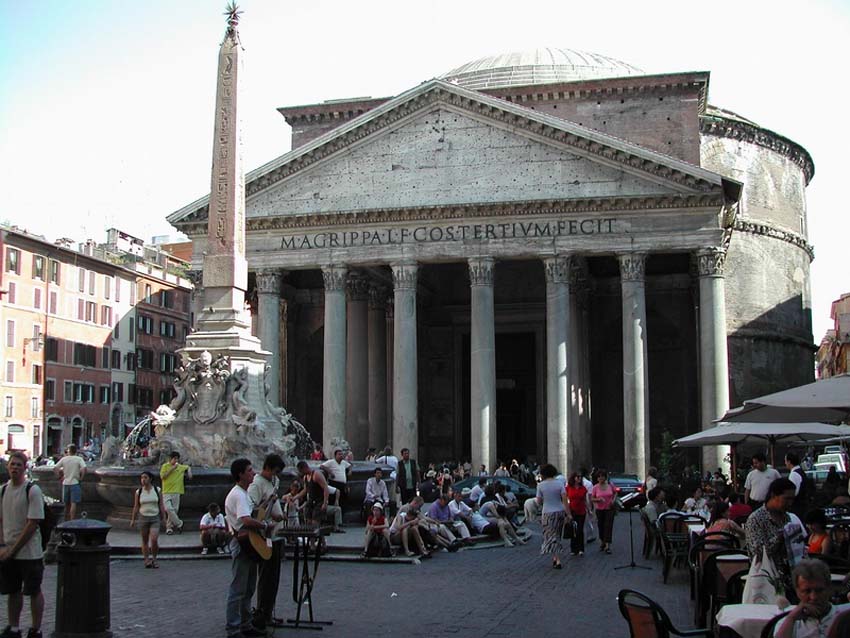
The Pantheon in Piazza Rotonda. This is at least the third iteration of the temple: Hadrian had the name of Marcus Agrippa, the builder of the first Pantheon, inscribed on this the final temple. The Pantheon survived the depredations of later ages because it became a Christian church in medieval times. The obelisk was brought to Rome from Egypt to decorate the Roman Temple of Isis, which stood about 150 meters north of the pantheon. Our lunch was at the outdoor restaurant at the right side of the picture.
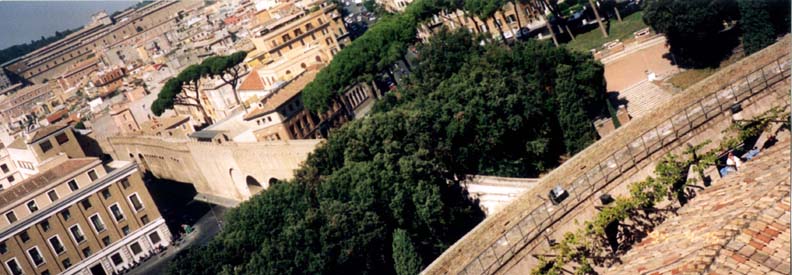
Passetto, seen from Castel Sant'Angelo. The passetto is a covered escape route connecting the Vatican (distance) to Castel Sant'Angelo. It is built atop the remains of an earlier wall that protected the "borgo", an area around the Vatican that had been fortified to protect it against sea-borne barbarians who raided up the Tiber River.
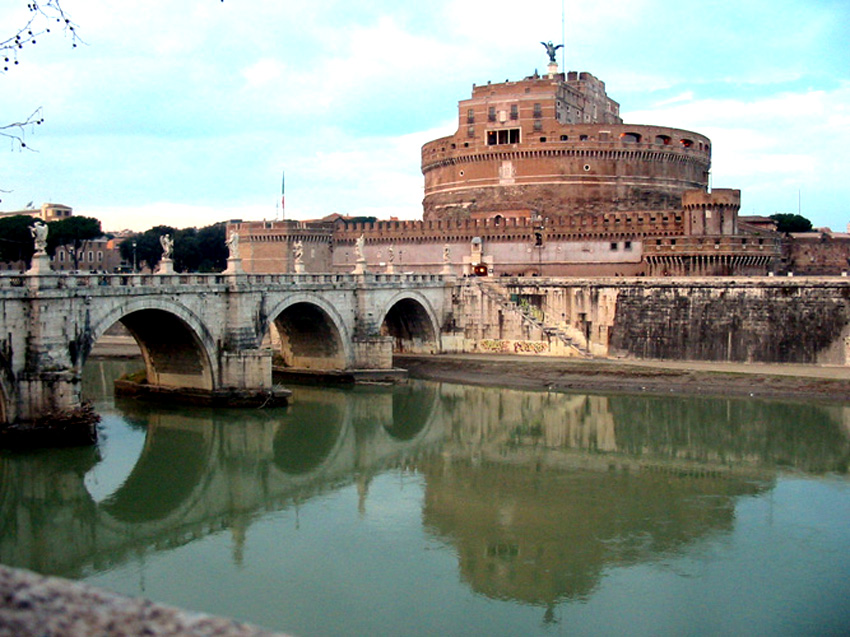
Castel Sant'Angelo, originally was built as Hadrian's tomb, but it fell into ruins. It later was turned into a fortress to protect the Vatican. The crenelated pentagonal outer works and the newer-looking top third of the interior drum date from renaissance times.The bridge is now called Ponte Sant'Angelo, and it was originally built by emperor Hadrian in 133-134 AD to connect his mausoleum to the Campus Martius. The original bridge, called Ponte Aelius after Hadrian's Family name, lasted until the Jubilee year of 1450 AD when the ancient bridge partially collapsed just before christmas as a huge throng of pilgrims were crossing the bridge on their way to the Vatican. More than 200 perished in the river. Only the three central arches of Hadrian's bridge survived the disaster. Pope Nicholas V ordered the repair of the bridge, but it was done hastily. Later Gian Lorenzo Bernini was commissioned to permanently restore the bridge. Bernini also designed the marble statues that adorn the bridge, but they were actually carved by his pupils. Bernini actually did carve two angels for the bridge with his own hand, but they were considered to valuable to be put out in the weather. Click here for more information on Bernini's masterful angel sculptures and the imagery of angels during the Renaissance.
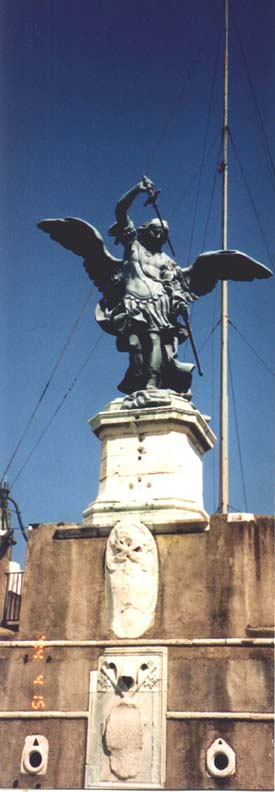
Archangel Michael, Bronze statue at the top of Castel Santangelo. The bronze statue of the Archangel Michael crowning the battlements today was made by Pietro van Verschaffelt in the mid-18th century. It is the sixth angel statue to occupy the pinacle. During the invasion of 1798 Napoleon's army painted it with the colors of the French Revolutionary Tricolor.
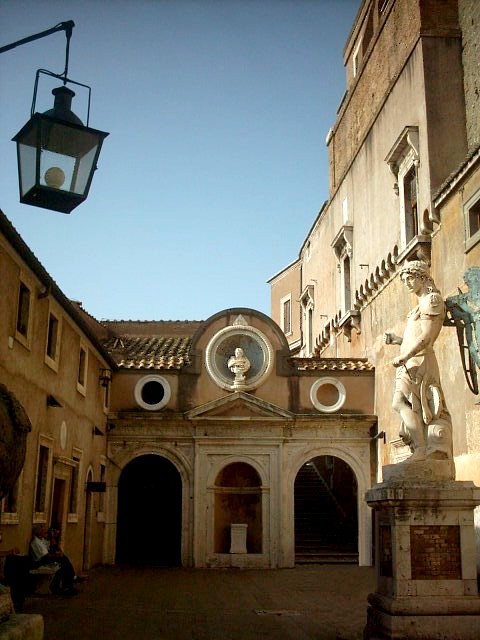
The Renaissance Angel that stood atop Castel Sant'Angelo before the current Angel was installed. Note that Angels didn't acquire their wings until late in the Renaissance when images of Roman "Victories" were identified as "Angels". The exceedingly ugly wings attached to this Angel are a late addition. The location is the "Courtyard of the Angel", which was called the "Courtyard of the Balls" until the stone balista balls that were formerly piled around the Angel were moved to another courtyard.
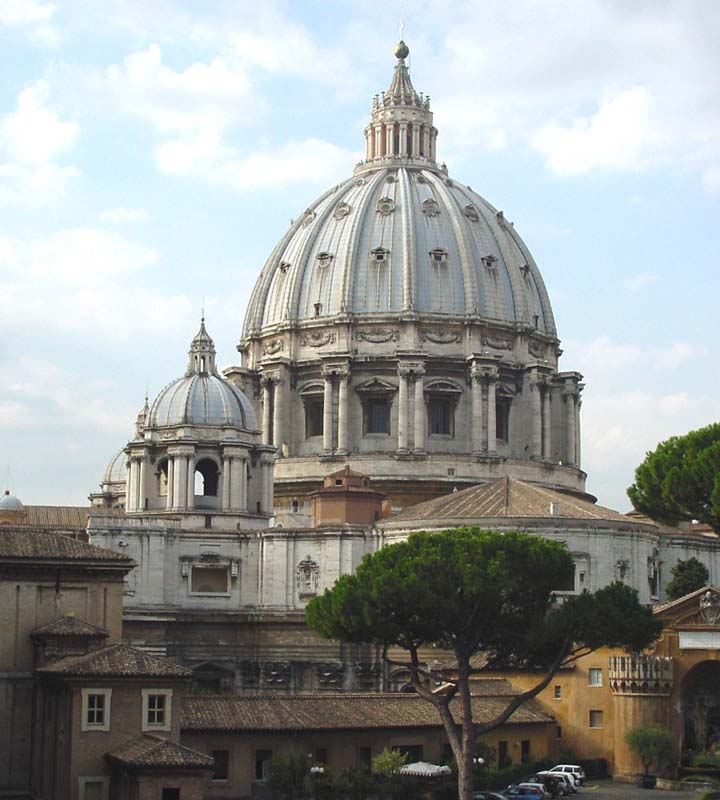
Michelangelo's dome for St. Peter's Church (finished 1626, two years after Michelangelo died). The photo was shot from a window in the Hall of Maps of the Vatican Museum
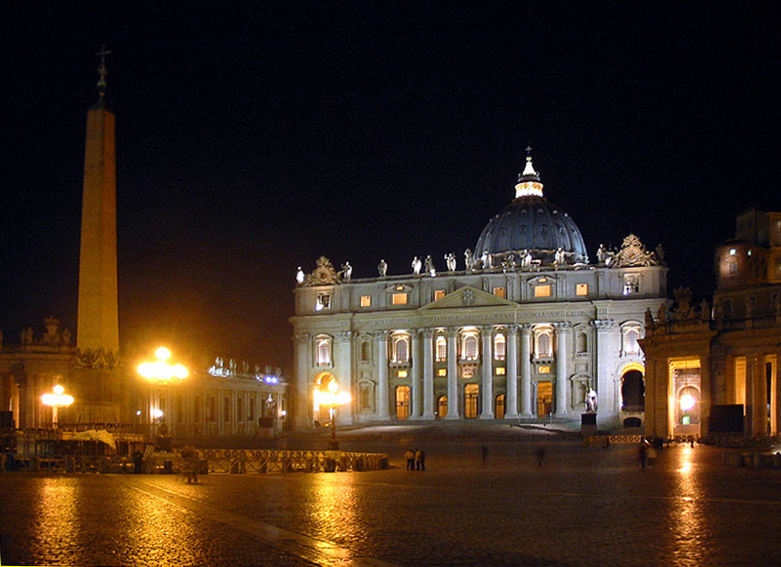
Night-time view of St. Peter's Church in the Vatican -- façade, dome, and final overall design by Michelangelo. The obelisk was brought to Rome from Alexandria in ancient times and was placed at the center of the spina (center wall, around which chariots raced) of Nero's stadium. It was said that St. Peter was executed at the base of the obelisk after the great fire during Nero's reign and that he was burried in the adjoinig cemetery -- the burial site determined the location of the Constantinian Basilica, "Old St. Peters". The obelisk was moved to its present position a few years before the present Basilica, "New St. Peters", was built.
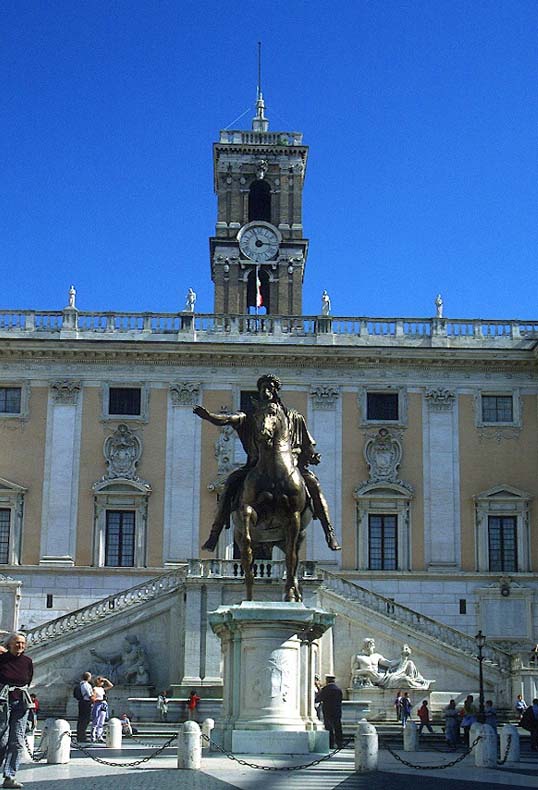
Statue of Marcus Aurelius on the Campidoglio (Capitoline Hill) in front of the Palazzo Senatorio (Rome's city hall). This statue is a replica, the original of which is in a climate-controlled display in the Palazzo Nuova Museum, also on the Capitoline. The original statue is the only equestrian bronze monumental sculpture that has survived since ancient times, and it survived only because of mistaken identity -- for centuries it was thought to be Constantine and therefore it was preserved by Christians who had no scruples about melting down "pagan" statuary. The front of the Palazzo Senatorio was designed by Michelangelo as part of his overall redesign of the Campidoglio for Pope Paul III Farnese and completed after his death by his students.
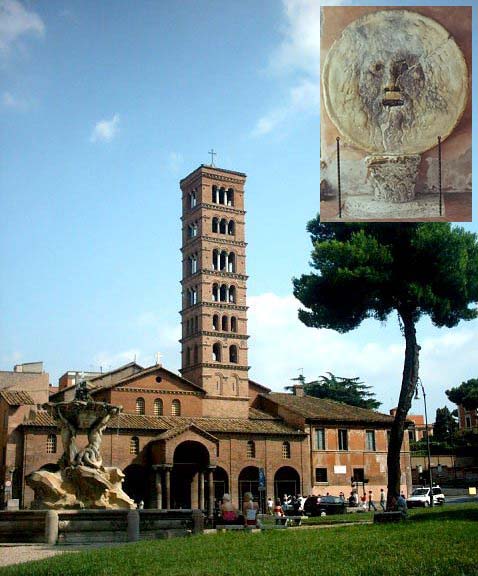
Church of Santa Maria in Cosmedin, location of the Bocca della Verità (Mouth of Truth) -- in the Forum Boarium
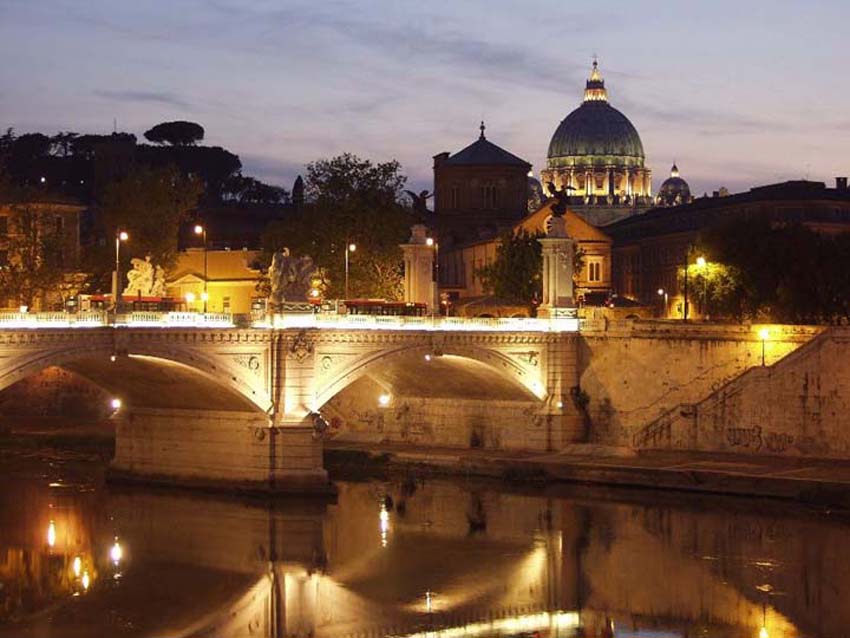
Looking across the Tiber River toward St. Peter's Church -- dawn
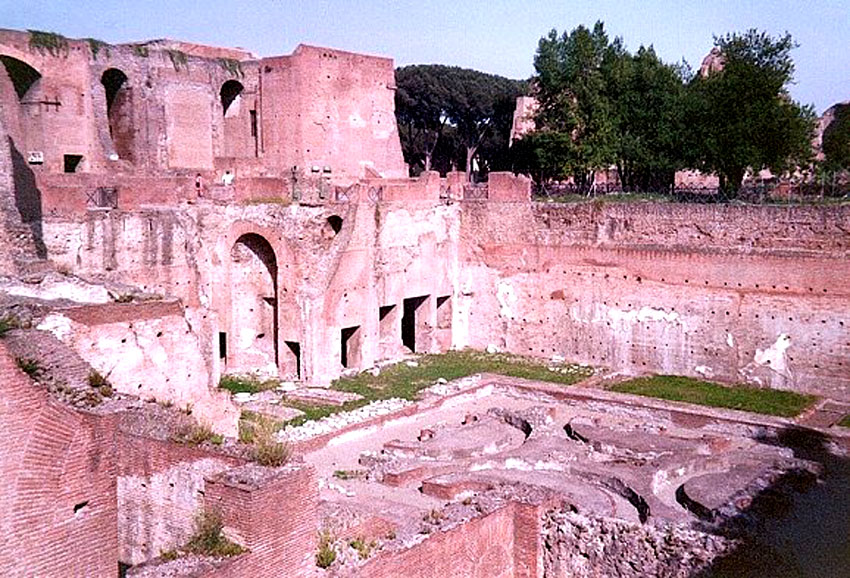
Palatine Hill -- Part of the palace of the Caesars, begun by Augustus who combined four pre-existing Republican villas. Later Emperors expanded the compound until it surged beyond the edges of the Palatine Hill.
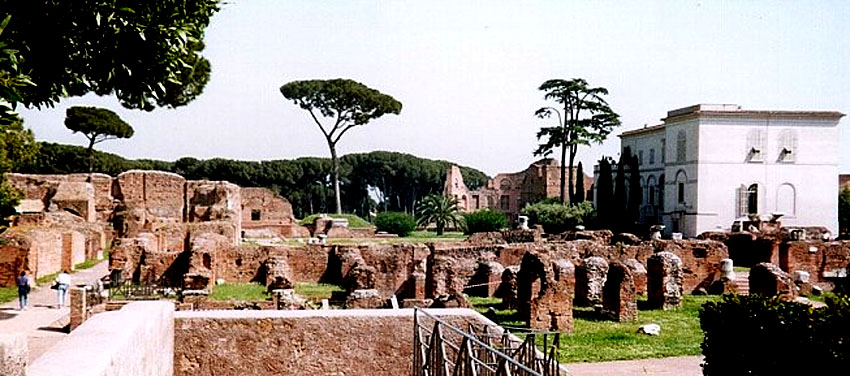
More of the Palatine Palace ruins, and in their midst the Palatine Museum.
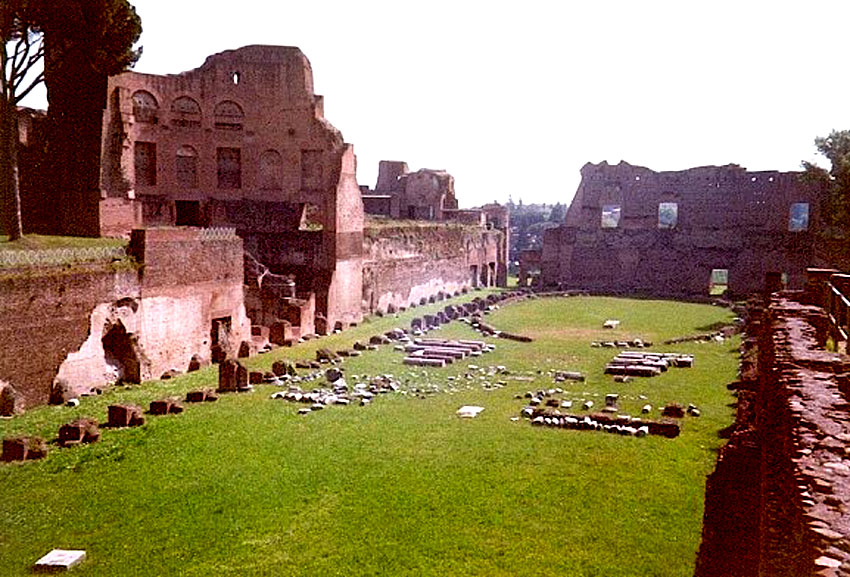
The Palatine Hill -- Domitian's private stadium, built into the palace compound and used by Domitian and later Emperors for private gladiator shows and equestrian exercise. Nobody knows the origin or purpose of the smaller oval ring of stones at the far end.
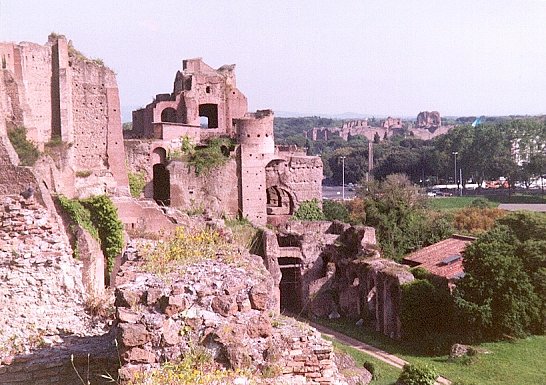
The Palatine Hill -- Parts of the Palace spilled over the hill's edges, this section on the side facing the Circus Maximus. The ruins in the background are what is left of the Baths of Caracalla
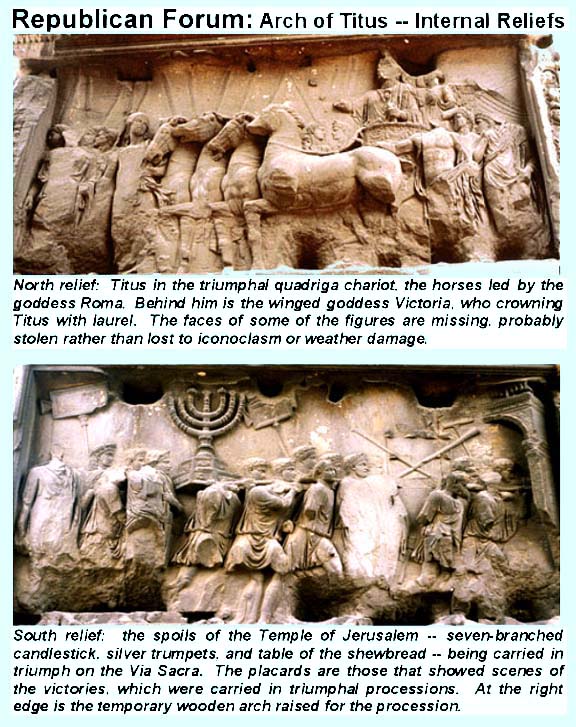
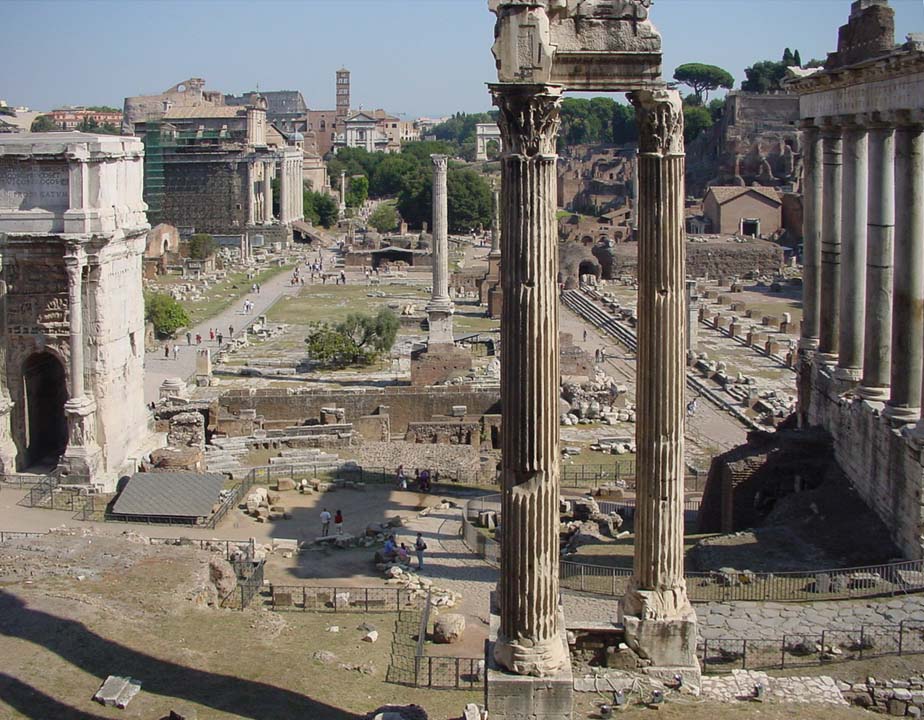
View of the Republican Forum from the Tabularium (below the Palazzo Senatorio, Rome's "city hall"). The pillars of the temples of Vespasian and Titus (foreground) and of Saturn (right) were re-erected after the excavations of Rodolfo Lanciani in the 1890s. The Arch of Septimius Severus is in the left foreground, and the arch of Titus is at the far end of the Forum. The foliage beside the celebratory 7th century AD Pillar of Phocas (center) is an olive tree, a fig tree, and a grape vine, supposedly clones of those planted at the beginning of the ancient Roman Republic. Beyond the planting and the Pillar of Phocas, under the slightly peaked roof, is the ruin of the the altar on which the body of Julius Caesar was burned after his assassination.
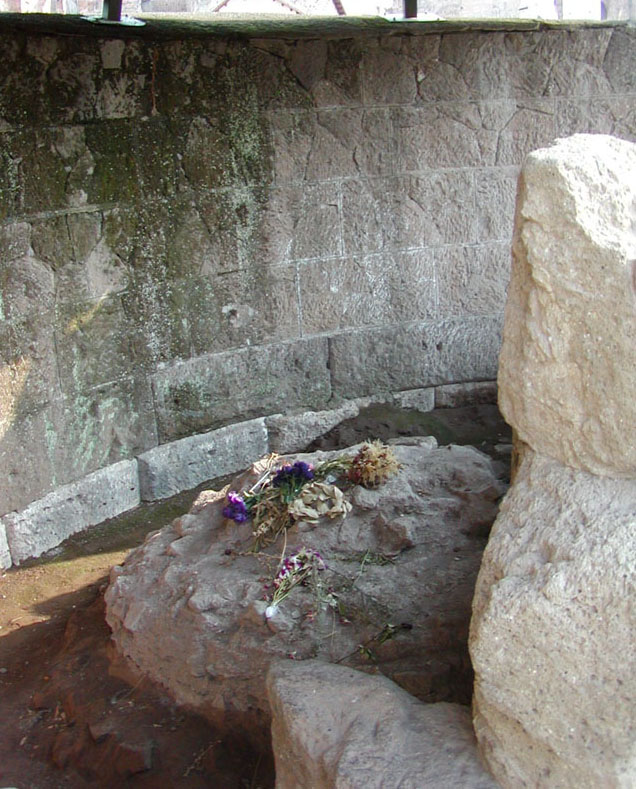
The altar of Caesar's immolation. Fresh flowers are placed daily, reputedly by neo-Fascists who still revere his memory.